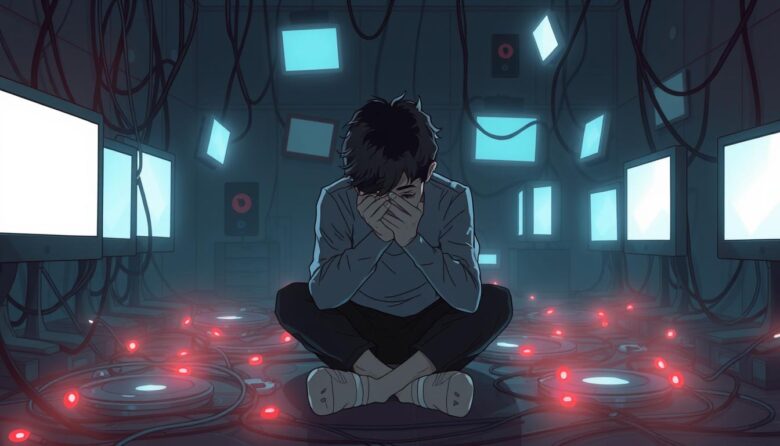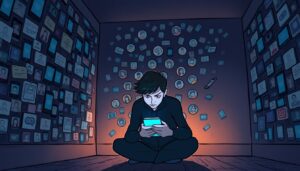Modern life connects us faster than ever, yet many struggle with feelings of isolation. Digital platforms reshape how we interact, creating new hurdles for emotional resilience. Public figures like Jennifer Lopez openly share their battles—her album This Is Me…Now details how personal setbacks led to relationship dependency. Her story mirrors challenges countless individuals face silently.
Virtual spaces amplify vulnerability. A single ignored message or unanswered post can trigger disproportionate distress. Unlike private conversations, digital interactions leave permanent trails visible to strangers and peers alike. This exposure intensifies emotional responses, making setbacks feel like public failures.
Current research highlights three critical shifts: immediacy of feedback, loss of contextual cues, and perceived permanence of negative experiences. Dating apps allow instant dismissal with a swipe. Professional networks showcase career milestones while hiding rejections. Creative communities often prioritize viral success over gradual growth.
Understanding these dynamics helps explain why setbacks now carry heavier psychological weight. The key lies in reframing setbacks as universal human experiences rather than personal shortcomings. With intentional strategies, individuals can rebuild confidence without external validation.
Understanding the Impact of Digital Rejection
Platforms now measure worth through invisible metrics. Likes and follower counts act as social thermometers, quantifying approval in real time. This visibility transforms personal interactions into public performance art.
Social Media’s Role and the Spread of Rejection
Algorithms prioritize viral content over meaningful connections. A post with low engagement lingers indefinitely, creating lasting evidence of perceived failure. Viral potential amplifies anxiety—a harsh comment might reach thousands within hours.
Career setbacks arrive via impersonal emails. Unlike face-to-face feedback, these messages lack tone or context. Studies show 68% of professionals recall digital rejections more vividly than in-person ones.
Internalizing Criticism in the Digital Realm
Brain scans reveal social pain activates neural pathways similar to physical injury. Digital spaces intensify this effect through constant accessibility. Users check devices 58 times daily on average, creating endless opportunities for negative encounters.
Creative communities face unique challenges. A rejected pitch or ignored submission often sparks self-doubt. Without verbal cues, creators imagine worst-case scenarios about their work’s value.
How online rejection and self-esteem Shapes Personal Identity
The quest for likes begins long before we hold smartphones. Childhood experiences with caregivers create blueprints for self-worth. When affirmation feels conditional, people often carry that pattern into digital spaces.
Recognizing External Validation Needs
Many adults unknowingly replay childhood dynamics through screens. A “like” becomes a parent’s smile. A ignored comment feels like family disapproval. These reactions form during early years when praise shaped our sense of being good enough.
Social platforms amplify this cycle. Notifications act as approval meters, measuring worth through follower counts. Users chase metrics instead of building authentic identity. Over time, personal value gets tied to viral potential rather than inner growth.
Breaking free starts with awareness. Notice when digital feedback triggers childhood insecurities. Replace comparison with self-compassion. True confidence grows when validation comes from within, not trending algorithms.
Practical Ways to Cope with Online Rejection
Building resilience starts with actionable daily habits. Small changes in routine create lasting armor against digital stress. Focus on progress, not perfection—every step matters.
Effective Self-Care and Stress Management Techniques
Begin with breathing exercises during screen breaks. Inhale for four counts, hold for seven—this resets the nervous system. Cognitive reframing helps transform thoughts like “I failed” into “I learned.”
Set specific time blocks for app usage. Use phone settings to lock social platforms after reaching daily limits. Therapy offers structured tools to process setbacks, particularly when feelings persist beyond two weeks.
Building Supportive Social Networks
Join local clubs aligning with personal interests—book groups or hiking teams. Face-to-face interactions with friends activate serotonin production, countering digital anxiety. Schedule weekly coffee meetups as non-negotiable appointments.
Create tech-free zones at home. Designate dinner tables as conversation spaces, not scrolling areas. Track personal achievements through journaling—completed work projects or new skills mastered. This builds satisfaction rooted in real growth.
Insights from Therapy, Writing, and Academic Perspectives
Behind every success story lies a trail of unnoticed efforts and silent setbacks. Creative professionals and public figures alike navigate rejection’s emotional terrain, often hiding their struggles beneath polished exteriors. Research reveals universal patterns in how humans process exclusion across careers and relationships.
Celebrity Experiences and the Search for Self-Love
Jennifer Lopez’s album This Is Me…Now candidly explores using relationships to fill emotional voids. Her journey mirrors author René Ostberg’s 2017 crisis after 17 consecutive writing rejections. “Each ‘no’ felt like erasing part of my identity,” Ostberg recalls. Therapists recommend reframing such setbacks as proof of effort—a strategy many artists adopt by aiming for 100 rejections annually.
Academic Studies on Rejection Sensitivity
Neuroscience shows heightened activity in pain-processing brain regions during social exclusion. Studies link rejection sensitivity to increased depression risk, particularly when individuals perceive authority figures as dismissive. Dating app research reveals romantic dismissals trigger deeper self-doubt than other forms of exclusion.
Cognitive-behavioral therapy helps clients separate personal worth from outcomes. “A publisher’s ‘no’ often reflects market fit, not writing quality,” explains therapist Dr. Elena Torres. By viewing rejections as compatibility filters rather than failures, individuals build resilience rooted in self-validation.
Embracing Change While Moving Forward
Personal growth often emerges from life’s most challenging moments. Shifting your view of setbacks as stepping stones—not roadblocks—creates space for meaningful progress. Therapists emphasize focusing on relationship patterns rather than isolated rejections, revealing paths to healthier connections.
Modern dating culture demands resilience. Each unmatched profile or canceled date offers data about compatibility, not personal worth. Frame these experiences as filters guiding you toward aligned partners.
Set goal-oriented boundaries in digital spaces. Schedule weekly tech-free dinners with friends to nurture real-world bonds. Track small wins in a journal to build identity rooted in action, not approval metrics.
Success lies in consistent steps, not instant results. A breakup or career setback becomes transformative when viewed through growth-focused lenses. As Jennifer Lopez’s journey shows, lasting satisfaction stems from self-defined purpose—not fleeting validation.



